Beavis and Butt-Head is an American adult animated sitcom created by Mike Judge. The series follows Beavis and Butt-Head, both voiced by Judge, a pair of teenage slackers characterized by their apathy, lack of intelligence, lowbrow humor and love for hard rock and heavy metal. The original series juxtaposes slice-of-life short subjects—in which the teens embark on low-minded misadventures in their Texas town—with the pair watching and commenting on music videos.

Zoop is a puzzle video game originally developed by Hookstone and published by Viacom New Media in 1995 for the Genesis, Super Nintendo Entertainment System, MS-DOS, Macintosh, PlayStation, Game Gear, and Game Boy, then in 1996 for the Saturn and Jaguar. Zoop has similarities to Taito's 1989 arcade video game Plotting, but Zoop runs in real-time instead. Players are tasked with eliminating pieces that spawn from one of the sides of the screen before they reach the center of the playfield. By pointing at a piece and shooting it, the player can either swap it with the current player color and thus arrange the same color pieces in a row or column, or match the color.

Earthworm Jim is a 1994 run and gun platform game developed by Shiny Entertainment, featuring an earthworm named Jim, who wears a robotic suit and battles the forces of evil. The game was released for the Sega Genesis and Super Nintendo Entertainment System, before being subsequently ported to several other video game consoles.

Primal Rage is a fighting game developed and released by Atari Games for arcades in 1994. The game takes place on a post-apocalyptic version of Earth called "Urth". Players control one of seven prehistoric beasts, that battle each other to determine the planet's fate. Matches feature many of the conventions of fighting games from the era, including special moves and gory finishing maneuvers. Ports were released for home video game consoles and personal computers. Efforts to perfectly emulate the arcade original have been unsuccessful due to the use of an unusual copy protection method. Toys, comics, a novel and other merchandise tie-ins were produced. More than 1.5 million copies of the game were sold.

The Itchy & Scratchy Game is a platform video game that was released for the Super NES, and Game Gear. It stars the cat and mouse pair Itchy & Scratchy from the adult animated sitcom The Simpsons, and features the classic gory violence from the show. The main character is Itchy, who has to fight Scratchy. Reception of the game has been generally negative.
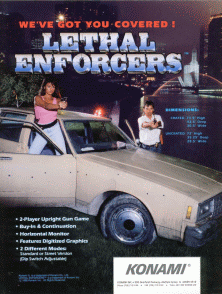
Lethal Enforcers is a 1992 light gun shooter released as an arcade video game by Konami. The graphics consist entirely of digitized photographs and digitized sprites. Home versions were released for the Super NES, Genesis and Sega CD during the following year and include a revolver-shaped light gun known as The Justifier.
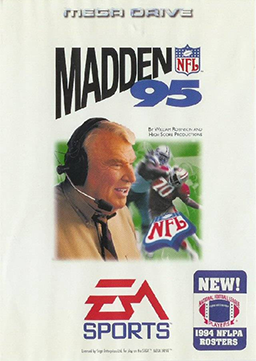
Madden NFL 95 is a football video game released by Electronic Arts in 1994. In addition to the usual home console versions that were released on the Sega Genesis and Super NES, this edition was also released for the portable Game Gear and Game Boy systems. It was the first version of the game that portrayed black NFL players as black, rather than all white as in previous versions, and the first in the Madden series to portray black athletes on the cover. It was also the first game in the series to have the official NFLPA license.

Captain America and the Avengers is a beat 'em up arcade game developed and released by Data East in 1991. It features the Avengers team of Marvel Comics characters in a side-scrolling brawling and shooting adventure to defeat the evil Red Skull. The game received ports for the Sega Genesis/Mega Drive, Super Nintendo Entertainment System, Game Boy and Game Gear. A different Data East game was released for the Nintendo Entertainment System.

Disney's The Jungle Book is a series of platform video games based on the 1967 Disney animated film of the same name. The game was released by Virgin Interactive Entertainment in 1994 for the Game Boy, Nintendo Entertainment System, Master System, Genesis/Mega Drive, Game Gear, Super Nintendo Entertainment System, and MS-DOS. While gameplay is the same on all versions, technological differences between the systems forced changes – in some case drastic – in level design, resulting in six fairly different versions of the 'same' game. This article is largely based upon the Genesis/Mega Drive version.

The Lion King is a platform game based on Disney's 1994 animated film of the same name. The game was developed by Westwood Studios and published by Virgin Interactive Entertainment for the Super NES and Genesis in 1994, and was ported to MS-DOS, Amiga, Game Gear, Master System, and Nintendo Entertainment System. The Amiga, Master System, and NES versions were only released in the PAL region. It is the final licensed NES game worldwide. The game follows Simba's journey from a young cub to the battle with his uncle Scar as an adult.
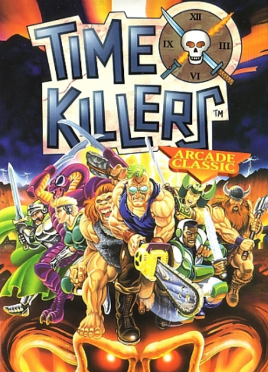
Time Killers is a 1992 weapon-based fighting arcade game developed by Incredible Technologies and published by Strata. Along with Allumer's Blandia, Time Killers is one of the earliest weapon-based fighting games modeled after Capcom's Street Fighter II (1991). It was later overshadowed by the success of SNK's 1993 weapon-based fighting game, Samurai Shodown. In Time Killers, eight warriors from different periods in history face off with each other, and then Death, for a chance at immortality.

MLBPA Baseball, known in Japan as Fighting Baseball, is a baseball video game for the Super NES, Mega Drive/Genesis, and Game Gear.

Batman Forever is a beat 'em up video game based on the film of the same name. Though released by the same publisher at roughly the same time, it is an entirely different game from Batman Forever: The Arcade Game. The game was followed by Batman & Robin in 1998.

Mighty Morphin Power Rangers is the title of five different video games based on the first season of the television series of the same name, one for each of the following game platforms: Sega Genesis/Mega Drive, Super Nintendo Entertainment System, Game Boy, Game Gear, and Sega CD. The Nintendo versions of the game were released by Bandai, while the Sega versions were published by Sega itself and the production of the cartridge versions was carried by Banpresto, a pseudonym of Bandai. The Green Ranger is only playable on the Genesis and Game Gear versions of the game.

Dragon: The Bruce Lee Story is a fighting video game developed and originally published by Virgin Interactive Entertainment in Europe for the Sega Genesis in June 1994. It is based on the 1993 film of the same name, which is a semi-fictionalized account of the life of Hong Kong-American actor and martial artist Bruce Lee. Following the events of the movie, players take control of Bruce Lee across several stages that takes places in different time periods of his life and fight against some of his adversaries.

Mighty Morphin Power Rangers: The Movie is the title of four different video game adaptations of the film of the same name which were released for the Super NES, Genesis, Game Boy, and Game Gear. While the games are ostensibly based on the film, they also feature characters and plot elements from the second season of the original TV series. Like the previous game versions of the original Mighty Morphin Power Rangers, none of the four versions of the movie game are ports of each other.
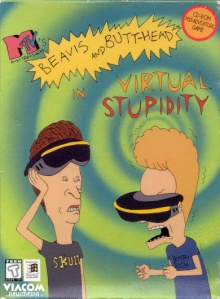
Beavis and Butt-Head in Virtual Stupidity is a point-and-click adventure computer game based on the American animated television series created by Mike Judge, Beavis and Butt-Head, that was developed by ICOM Simulations and published by Viacom New Media.

Samurai Shodown, known in Japan as Samurai Spirits, is a fighting game developed and published by SNK for the Neo Geo arcade and home platform. Released in 1993, it is the first installment in the Samurai Shodown series. In contrast to other fighting games at the time, which were set in modern times and focused primarily on hand-to-hand combat, Samurai Shodown is set in feudal-era Japan and was SNK's first arcade fighting game to focus primarily on weapon-based combat.

FIFA Soccer 96 is a football video game developed by Extended Play Productions and released by Electronic Arts in 1995. It was released for the Mega Drive/Genesis, Sega Saturn, Sega 32X, Game Gear, PlayStation, Super Nintendo Entertainment System, and MS-DOS compatible operating systems.
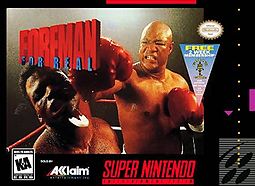
Foreman For Real is a 1995 boxing video game for the Game Boy, Game Gear, Sega Genesis, and the Super Nintendo Entertainment System featuring George Foreman. It is the follow-up to Acclaim's previous release, George Foreman's KO Boxing. The game was met with negative reviews which criticized the simplistic and unexciting gameplay and low production values.


















